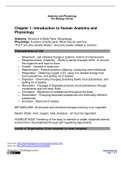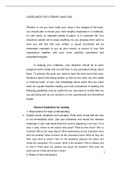Jaytush2721
On this page, you find all documents, package deals, and flashcards offered by seller jaytush2721.
- 36
- 0
- 0
Community
- Followers
- Following
36 items

Human anatomy, read the summary and get first class honors
three major steps in forming ATP (called cellular respiration) a. glycolysis (1) in cytosol (2) glucose 2 pyruvic acid (a series of steps) (3) yields 2 ATP/glucose (not very efficient by itself) (4) attach H to carrier molecules b. citric acid cycle (also called Krebs cycle or tricarboxylic acid cycle) (1) pyruvic acid is transported to mitochondrial matrix (2) pyruvic acid acetyl CoA (3) acetyl CoA enters citric acid cycle, which is a series of reactions (4) CO2 is produced (5) hyd...
- Summary
- • 97 pages •
three major steps in forming ATP (called cellular respiration) a. glycolysis (1) in cytosol (2) glucose 2 pyruvic acid (a series of steps) (3) yields 2 ATP/glucose (not very efficient by itself) (4) attach H to carrier molecules b. citric acid cycle (also called Krebs cycle or tricarboxylic acid cycle) (1) pyruvic acid is transported to mitochondrial matrix (2) pyruvic acid acetyl CoA (3) acetyl CoA enters citric acid cycle, which is a series of reactions (4) CO2 is produced (5) hyd...

Human anatomy, read the summary and get first class honors
three major steps in forming ATP (called cellular respiration) a. glycolysis (1) in cytosol (2) glucose 2 pyruvic acid (a series of steps) (3) yields 2 ATP/glucose (not very efficient by itself) (4) attach H to carrier molecules b. citric acid cycle (also called Krebs cycle or tricarboxylic acid cycle) (1) pyruvic acid is transported to mitochondrial matrix (2) pyruvic acid acetyl CoA (3) acetyl CoA enters citric acid cycle, which is a series of reactions (4) CO2 is produced (5) hyd...
- Summary
- • 97 pages •
three major steps in forming ATP (called cellular respiration) a. glycolysis (1) in cytosol (2) glucose 2 pyruvic acid (a series of steps) (3) yields 2 ATP/glucose (not very efficient by itself) (4) attach H to carrier molecules b. citric acid cycle (also called Krebs cycle or tricarboxylic acid cycle) (1) pyruvic acid is transported to mitochondrial matrix (2) pyruvic acid acetyl CoA (3) acetyl CoA enters citric acid cycle, which is a series of reactions (4) CO2 is produced (5) hyd...

Human anatomy, read the summary and get first class honors
three major steps in forming ATP (called cellular respiration) a. glycolysis (1) in cytosol (2) glucose 2 pyruvic acid (a series of steps) (3) yields 2 ATP/glucose (not very efficient by itself) (4) attach H to carrier molecules b. citric acid cycle (also called Krebs cycle or tricarboxylic acid cycle) (1) pyruvic acid is transported to mitochondrial matrix (2) pyruvic acid acetyl CoA (3) acetyl CoA enters citric acid cycle, which is a series of reactions (4) CO2 is produced (5) hyd...
- Summary
- • 97 pages •
three major steps in forming ATP (called cellular respiration) a. glycolysis (1) in cytosol (2) glucose 2 pyruvic acid (a series of steps) (3) yields 2 ATP/glucose (not very efficient by itself) (4) attach H to carrier molecules b. citric acid cycle (also called Krebs cycle or tricarboxylic acid cycle) (1) pyruvic acid is transported to mitochondrial matrix (2) pyruvic acid acetyl CoA (3) acetyl CoA enters citric acid cycle, which is a series of reactions (4) CO2 is produced (5) hyd...

Human anatomy is a tricky unit at sometimes, so I have these summaries which when you support my work by buying they will help you get a straight A in your course study.
Body Cavities (see p.9) A. Dorsal Cavity ---Cranial Cavity - Brain, Spinal Cavity - Spinal Cord B. Ventral Cavity 1. Thoracic Cavity - right and left compartment separated by mediastinum. Heart , lungs, esophagus, trachea 2. Abdominopelvic Cavity ---Abdominal cavity - stomach, spleen, liver, gall bladder, small intestine ---Pelvic cavity - part of the large intestine, urinary bladder, reproductive organs *Thoracic and abdominopelvic cavity separated by DIAPHRAGM *The organs within th...
- Summary
- • 5 pages •
Body Cavities (see p.9) A. Dorsal Cavity ---Cranial Cavity - Brain, Spinal Cavity - Spinal Cord B. Ventral Cavity 1. Thoracic Cavity - right and left compartment separated by mediastinum. Heart , lungs, esophagus, trachea 2. Abdominopelvic Cavity ---Abdominal cavity - stomach, spleen, liver, gall bladder, small intestine ---Pelvic cavity - part of the large intestine, urinary bladder, reproductive organs *Thoracic and abdominopelvic cavity separated by DIAPHRAGM *The organs within th...

introduction to psychology
provides what you need to know about psychology
- Summary
- • 1 pages •
provides what you need to know about psychology

counselling psychology
well written summary about counselling psychology
- Summary
- • 57 pages •
well written summary about counselling psychology

research methods for sports performance methods
performance analysis is an area of sport and exercise science concerned with actual sports performance rather than self-reports by athletes or laboratory experiments.
- Summary
- • 295 pages •
performance analysis is an area of sport and exercise science concerned with actual sports performance rather than self-reports by athletes or laboratory experiments.

literary language
provides in depth information about Literary language in literature materials
- Summary
- • 14 pages •
provides in depth information about Literary language in literature materials

sports psychology
provides an in-depth elaboration on sports psychology
- Exam (elaborations)
- • 961 pages •
provides an in-depth elaboration on sports psychology

introduction to computer studies
this document provides students with simple notes that will help a student to pass with good grades
- Exam (elaborations)
- • 120 pages •
this document provides students with simple notes that will help a student to pass with good grades
